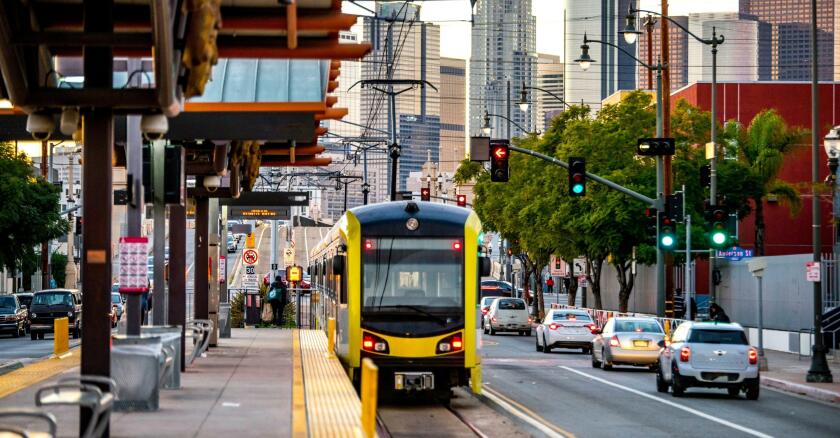New technologies in payments, mapping and digital products are coming to the nation’s second largest public transit agency, as it adds service and ridership continues to climb from its pandemic nadir.
L.A. Metro, Fernando Dutra, the new Los Angeles County Metropolitan Transportation Authority (Metro) Board chair, said, aims to “deliver a safe and efficient world-class transit service.”
“We’re planning to deliver a world-class system for generations to come,” he said Wednesday at Metro’s annual State of the Agency gathering, when officials typically reflect on accomplishments and lay out new initiatives.
Metro will soon unveil systemwide technology upgrades enabling tap-to-ride modern fare-payment platforms, where riders simply tap their debit or credit cards as they board a bus or move through a turnstile.
The improvements will be used “just like you use a TAP card today,” Metro CEO Stephanie Wiggins said at the event, calling to mind the familiar reusable, reloadable TAP payment cards now in use.
Tap-to-pay tech is becoming increasingly common among U.S. transit providers intending to add convenience and forego cumbersome e-ticketing apps, vending machines and cash. Cities including Boston, Las Vegas, and Sacramento, Calif., have introduced tap-to-pay technologies.
“We’re also improving our digital tools,” Wiggins said, explaining Metro intends to introduce an “all-in-one app for everything Metro, to keep you in the know about when your bus or train is coming. No more scavenger hunts.”
The transit agency also plans to introduce “augmented reality in Google and Apple Maps to help get you to your destination more quickly and easily.”
All of these upgrades are aimed at setting Metro up for the city’s upcoming big events — namely, the FIFA World Cup events next year and the 2028 Summer Olympic Games.
During the World Cup events, Metro will add more than 300 buses to serve the thousands of domestic and international visitors to Los Angeles, helping it to prepare for what Wiggins called “the main event.” In 2028 Metro will be charged with handling more than 1 million additional daily riders during the Olympic Games, connecting attendees to more than 40 locations hosting Olympic events. A new temporary bus system designed for the games will add many buses to Metro’s fleet.
“I am confident we will meet this moment. Because like the elite athletes we will be hosting, we’ve been training,” she said, reminding the room who Metro’s No. 1 customer is.
“But let me be clear, we are not doing this just for the FIFA World Cup, the Super Bowl, or the 2028 Olympic and Paralympic Games. We’re doing this for you,” she said. “For every L.A. County resident who has helped us build this system, and who deserves a better, cleaner, safer, easier alternative to sitting in traffic.”
Metro officials heralded the opening of the new LAX/Metro Transit Center, a project six decades in the making, additions to extended train lines, and the deployment of more bus priority lanes, now on more than 70 miles of streets. These, Wiggins said, are “helping buses move faster and more reliably.” Ridership, she noted, has climbed more than 53 percent in the last four years, and customer satisfaction now sits at 87 percent. (Ridership during the first quarter of 2025 is still down 16.4 percent compared to the first quarter of 2019, according to Metro statistics.)
The new LAX transit center, which brings together two rail lines and multiple bus lines from across the region, opened last month. For now, dedicated airport shuttles run every 10 minutes from the transit center until the Los Angeles World Airports Automated People Mover train begins operation early next year — serving as the final piece seamlessly connecting public mass transit to the nation’s second busiest airport.
Reflecting on the past is never just about celebrating the wins. Public mass transit plays a ubiquitous role in the life of cities. And Los Angeles has not been without its struggles this year. Six months ago, the Eaton and Palisades fires decimated neighborhoods and thousands of homes and businesses.
And a few weeks ago, the region’s immigrant community was shaken by the presence of U.S. Immigration and Customs Enforcement, unleashing days of protest and a militarized federal response.
Metro officials stressed its continued service during these periods of unrest and displacement. Following the fires Metro made it easier to enroll in its free and reduced fare programs, targeting those affected.
“This is a year when Metro didn’t just operate. We showed up,” outgoing Metro Board Chair Janice Hahn said.
In February, Metro made “Know Your Rights” materials available on buses and stations, offering added information and services to undocumented riders.
“We will continue to support and protect our riders as best we can. And our riders need to know that if they exercise their right to peacefully protest, Metro stations will be open, and our buses and trains will be ready to get them back home safely,” Hahn said to a round of applause.
“It has been a difficult, a very difficult time, for many in our immigrant community,” Wiggins said. “Many of us have friends, neighbors and loved ones who have been impacted. And yet, in the face of uncertainty and pain, you continue to show up, with integrity, with compassion, and with the deep sense of duty to the people of this organization.”
Editor's note: This story was updated to reflect the correct decline in Metro ridership in the first quarter of 2025.
L.A. Metro Unveils Tech Upgrades Ahead of World Cup, Olympics
What to Know- L.A. Metro is implementing new technology, including tap-to-pay fare systems and augmented reality navigation, to improve convenience for riders.
- Ridership has grown by over 53 percent in the past four years, with significant efforts to enhance services ahead of events like the FIFA World Cup and the 2028 Olympics.








